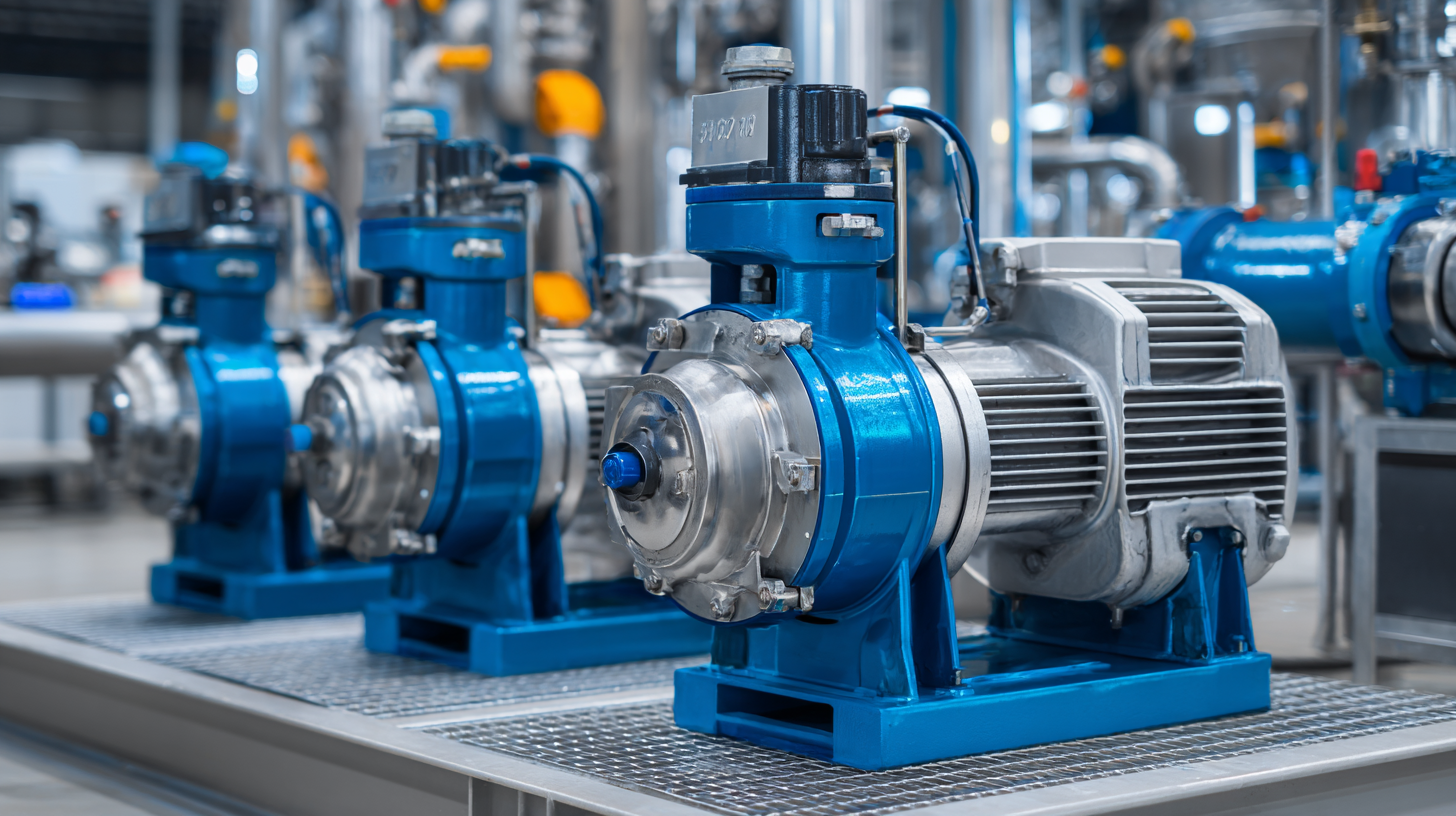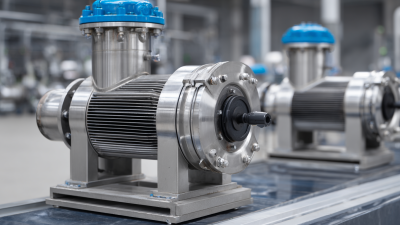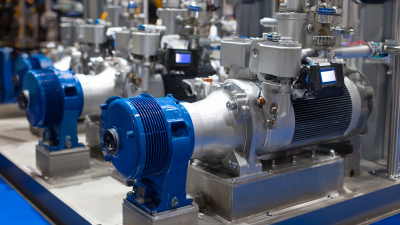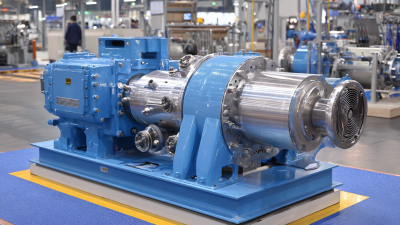Sealless Pumps for a Safer and Greener World


In the competitive and rapidly evolving landscape of chemical processing, selecting the right equipment is crucial for optimizing efficiency and ensuring safety. One such critical component is the magnetic drive pump, increasingly preferred for its ability to handle corrosive and toxic fluids without the risk of leakage. According to a recent market research report by Global Market Insights, the magnetic drive pump market is projected to reach USD 1.5 billion by 2027, highlighting the growing demand for reliable and efficient pumping solutions in various industrial applications.

Experts in the field, such as Dr. Emily Carter, a renowned specialist in fluid dynamics, emphasize the importance of selecting the appropriate magnetic drive pump for chemical processing. "The right choice of magnetic drive pumps not only enhances system efficiency but also significantly reduces the risk of environmental hazards," she stated in her 2022 study on pump technologies. This underscores the necessity for manufacturers and operators to understand the specifications and operational parameters of these pumps to leverage their full potential.
As industries continue to prioritize sustainability and efficiency, understanding the intricacies of magnetic drive pumps becomes increasingly vital. By making informed selections, businesses can not only optimize operational performance but also contribute to a safer and more sustainable industrial landscape.
When selecting magnetic drive pumps for chemical processing, it is crucial to consider the fluid characteristics and viscosity levels involved. Different fluids present unique challenges that can significantly affect pump performance and efficiency. For instance, fluids with high viscosity can lead to increased system resistance, requiring pumps that can maintain desired flow rates while minimizing energy consumption. According to a recent industry report, pumps designed for handling high-viscosity fluids can boost efficiency by as much as 15% compared to standard models, underscoring the importance of appropriate selection based on fluid properties.

In addition to viscosity, the chemical composition of the fluid must also be evaluated. Magnetic drive pumps, known for their leak-free operation, are often ideal for corrosive or hazardous materials. Selecting a pump that offers compatibility with specific chemicals not only ensures safe operation but also extends the lifespan of the equipment. Recent data indicates that improper pump selection can lead to maintenance costs increasing by up to 20% annually, reinforcing the necessity of thorough assessments that focus on both fluid characteristics and operational requirements. By aligning pump specifications with the intended application, facilities can achieve optimal efficiency and reliability in their processes.
When selecting magnetic drive pumps for chemical processing applications, material compatibility is pivotal for ensuring longevity and optimal performance. According to a report by the Chemical Engineering Research and Design Journal, nearly 40% of pump failures in chemical processes are attributed to material degradation due to chemical exposure. This highlights the necessity of choosing materials that can withstand the specific corrosive and abrasive properties of the chemicals being pumped.
Different materials such as PTFE, polypropylene, and stainless steel exhibit varying degrees of compatibility with different chemicals. For instance, PTFE is highly resistant to a wide range of acids and bases, making it a preferred choice for highly corrosive substances. A study by the American Society of Mechanical Engineers (ASME) emphasizes that using incompatible materials can lead to reduced efficiency, increased maintenance costs, and unscheduled downtimes, which can severely impact a facility's productivity. Therefore, conducting thorough chemical compatibility assessments is essential for optimizing pump selection and ensuring the reliability of chemical processes.

In chemical processing applications, selecting the right magnetic drive pump is critical for achieving optimal efficiency. A key aspect of this selection process is evaluating flow rate requirements. According to the Chemical Engineering Magazine’s 2021 Pump Survey, nearly 40% of facilities reported that improper pump sizing led to inefficiencies, increased energy consumption, and maintenance costs. To ensure that magnetic drive pumps operate within their optimal range, it’s essential to match the pump's flow rate characteristics with the specific demands of the application. Typically, pumps should be designed to handle the expected flow rates with a margin of safety to account for fluctuations in process conditions.
Efficiency metrics also play a vital role in pump performance. The Hydraulic Institute's latest standards indicate that magnetic drive pumps can achieve efficiency ratings exceeding 80%, significantly reducing energy expenses and enhancing sustainability in chemical operations. However, achieving these efficiency levels requires a thorough understanding of the system’s pressure requirements and fluid properties. In particular, factors such as viscosity and temperature can dramatically affect pump performance. Therefore, conducting a detailed evaluation of both flow rate and efficiency metrics will ensure that the selected magnetic drive pump not only meets operational demands but also contributes to the overall energy efficiency and reliability of the chemical processing system.
| Pump Model | Max Flow Rate (GPM) | Efficiency (%) | Media Compatibility | Power Consumption (HP) | Price Range ($) |
|---|---|---|---|---|---|
| Pump A | 75 | 85 | Acids, Bases | 5 | 2000 - 2500 |
| Pump B | 100 | 90 | Solvents | 7.5 | 2500 - 3000 |
| Pump C | 50 | 80 | Water, Glycol | 3 | 1500 - 2000 |
| Pump D | 80 | 88 | Chemicals | 5.5 | 1800 - 2300 |
| Pump E | 60 | 82 | Brine, Wastewater | 4 | 1600 - 2100 |
In the context of chemical processing applications, selecting the right magnetic drive pumps is crucial for optimizing efficiency and minimizing total costs. Energy consumption patterns play a significant role in determining the total cost of ownership (TCO). According to recent industry reports, the global market for industrial seals is projected to increase from $15.56 billion in 2025 to $22.62 billion by 2032, highlighting the growing importance of efficiency in industrial processes.
The integration of advanced technologies, such as variable-speed motors, can further enhance energy efficiency, allowing for substantial savings on power bills while contributing to sustainability goals.
Furthermore, innovations in motor technologies, such as synchronous reluctance motors, are proving to be effective for applications involving water pumping, where energy savings and reduced emissions become a priority. Oversizing pumps can lead to increased operational costs and inefficient energy use, making it critical to adhere to international standards that improve motor efficiency performance.
These evolving standards not only enhance pump performance but also align with global sustainability efforts, making energy-efficient solutions vital for chemical processing industries.
In chemical processing applications, maintaining the reliability of magnetic drive pumps is crucial for ensuring seamless operations. Key maintenance practices include regular inspections and adherence to manufacturer guidelines. Operators should pay close attention to wear components, seals, and bearings, as these elements can significantly impact the pump's efficiency and longevity. Scheduled maintenance checks help in early detection of potential issues, allowing for timely interventions that mitigate downtime.
Moreover, implementing effective monitoring techniques is vital for enhancing pump reliability. Utilizing advanced sensors can provide real-time data on pump performance, enabling operators to track flow rates, pressure levels, and temperature fluctuations. This information is essential for identifying unusual patterns that may indicate developing problems. Employing predictive maintenance strategies, such as vibration analysis and performance benchmarking, allows for data-driven decisions, ensuring pumps operate within optimal parameters and reducing the risk of unplanned failures in chemical processes.
This chart illustrates the efficiency levels of different magnetic drive pumps in chemical processing applications. Selecting a pump with higher efficiency can significantly enhance the overall performance and reliability of chemical processes.





